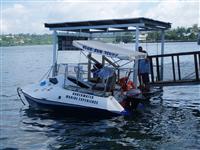
Study Marine Ecosystems from the comfort of your own home
- Work in marine conservation, tourism, diving, etc.
- A unique and very flexible opportunity to take the first step toward a fascinating career.
- Expert, university trained tutors help you learn and start building a network of contacts and resources - this is a very practical course!
This course is a terrific introduction for those wanting to work in the field of Marine Science. You will study a range of areas related to marine studies including marine ecological systems, reef formation and function, marine organisms including fish, cephalopods and marine mammals and the impacts of human activities on these fragile ecosystems.
COURSE STRUCTURE
This course has 9 lessons as follows:
- 1. Marine Ecology Systems
Ecology; Marine Weather (including El Nino, Thermocline, Gulf streams, etc), Continental shelf, Nutrient cycle, Red tide, Plankton, Marine Plants (including Mangroves, Shallow & Deep water algae, etc)
- Shallow Waters & Reefs
Coral Reefs, Rocky Shorelines, Estuaries, Introduction to marine arthropods
- Shellfish & Crustaceans
Molluscs and Brachiopods. True Crabs, Hermit Crabs, Lobsters, Prawns etc
- Squid, Octopus, and Other Primitive Animals
(Cephalopods and Clupeoids, etc)
- Fish Part A
(Cartilaginous Fish) Sharks, Eels, Rays; Shark Lifecycle, How dangerous are sharks? Effect of sharks on tourism, etc.
- Fish Part B
(Bony Fish) Fish Anatomy/structure (identifying external & internal parts); legalities (protection of wildlife), types of fish, etc
- Marine Mammals
(Dolphins, Whales, etc) Types of marine mammals, protection and politics, position of these animals in the food chain, products derived from marine mammals & substitutes for those products.
- Turtles, Sea Snakes and Seabirds
Types of turtles & sea snakes; toxicity of sea snakes; turtle protection, penguins and other sea birds (eg stints, knots, pelicans, swans, gulls, eagles, ibis, egrets, terns, shearwaters, gannets, albatross, prions, oyster-catchers and petrels).
- Human Impact on Marine Environments & Fishing
Human impact on marine environments; commercial vs recreational fishing, significance of certain mesopelagic fish, techniques for managing stocks of fish & other marine life.
Duration: 100 hours
Aims
- Identify characteristics of various marine environments
- Discuss the first basic groups of marine animal life
- Identify characteristics of various marine environments
- Discuss the first basic groups of marine animal life.
- Describe the range of molluscs and crustaceans in the marine environment and their lifecycles.
- Describe the biology and ecological significance of Cephalopods and Clupeoids in the marine environment.
- Describe a range of cartilaginous fish (sharks, rays) and selected bony fish (eels) that inhabit the ocean.
- Describe selected species and the diversity of marine fish that exists in the world’s oceans.
- Describe a range of marine mammals
- Discuss the presence of marine mammals in the seas and oceans of the world.
- Describe a range of reptiles and birds that co-habitat with fish in the marine environment.
- Explain the impact of humans upon marine environments and of selected aspects of commercial fishing.
Seagrasses
Seagrasses are not true grasses. They flower but the flowers are simplified and the pollen is moved by the tide. They produce small seeds which can move long distances by currents or inside fish. Populations often extend by complex rhizome systems, i.e.. systems of interconnected stems that connect shoots below the sediment surface.
The roots and horizontal stems (rhizomes), often buried in sand or mud, anchor the grasses and absorb nutrients. Leaves, usually green, are produced on vertical branches and also absorb nutrients. The stems and leaves of seagrasses contain veins and air channels so they can carry fluid and absorb gases. Seagrasses rely on light to convert carbon dioxide into oxygen (photosynthesis). The oxygen is then available for use by other living organisms.
Seagrasses occur in shallow temperate, subtropical and tropical coastal waters. The number of species is greater in the tropics than in the temperate zones. Their maximum depth is affected by light, so turbidity greatly reduces the depth to which they grow. They have a high cellulose content which makes them very tough, and relatively few species can graze on them.
Seagrass communities are one of the most productive and dynamic ecosystems. They provide habitats and nursery grounds for many marine animals, and act as substrate stabilisers. In some coastal areas, entire fisheries may depend on the productivity of these seagrass beds.
Seagrass meadows are a major food source for a number of grazing animals particularly the dugong (Dugong dugon) and the green turtle (Chelonia mydas) which mainly feed on seagrass. An adult green turtle eats about two kilograms of seagrass a day while an adult dugong eats about 28 kilograms a day. According to the World Conservation Union Dugongs are listed as Vulnerable. Globally, Green Turtle are listed as Endangered by the IUCN.
Why Study with ACS?
Design your own learning pathway.
Study at your own pace, from anywhere, at any time.
Receive prompt, expert support from our team of committed and friendly tutors.
Your learning is our priority. We are flexible and adaptable to meet your educational needs!
Want advice on creating a learning pathway that suits your needs? Speak to one of our friendly staff for today!
Phone - International: +61 7 5562 1088 In Australia: 07 5562 1088
Email - admin@acs.edu.au or studentservices@acs.edu.au